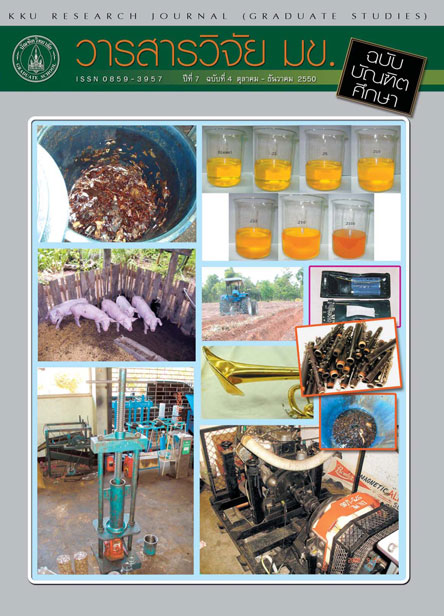Antimicrobial Resistance and Species Prevalence of Enterococcal Isolates in Srinagarind Hospital, Northeastern Thailand(การดื้อยาต่อต้านจุลชีพและความชุกของสปีชีส์ของเชื้อเอนเทอโรคอคคัสที่แยกได้ที่โรงพยาบาลศรีนครินทร์ ภาคตะวันออกเฉียงเหนือ ประเทศไทย)
Keywords:
Antimicrobial resistance(การดื้อต่ายาต้านจุลชีพ), Enterococcus species(เชื้อเอนเทอโรคอดคัส)Abstract
A total of 300 clinical isolates of enterococci, collected from patients admitted at Srinagarind hospital, were investigated for antimicrobial resistance and species distribution. Antimicrobial susceptibility to 10 antimicrobial agents was performed by disc diffusion method. Screening for vancomycin resistance was performed by the agar plate method and minimal inhibitory concentration of vancomycin was determined for vancomycin resistant strains by microbroth dilution method. Enterococcus faecalis was found to be predominant species (58.7%) followed by E. faecium (35.7%) and the rest species (5.7%) including E. hirae, E. gallinarum, E. durans and E. dispar. The isolates were resistant to penicillin (51.3%), ampicillin (43.3%), high level gentamicin (57.7%), azithromycin (100%), chloramphenicol (16.3%), doxycycline (48%), quinupristin/dalfopristin (53%) and linezolid (8%). None of the isolates were resistant to teicoplanin. Five (1.7%) strains were resistant to vancomycin. The minimal inhibitory concentrations of vancomycin for vancomycin-resistant enterococci strains were 16µg/ml. E. faecium was more resistant to penicillin, ampicillin and high level gentamicin than E. faecalis. Two hundred and seventy four (91.3%) strains showed multidrug resistance. Our study showed low prevalence of vancomycin resistance. However, there is a need to carry-out regular surveillance of antimicrobial resistance of enterococci to monitor changes in their patterns to prevent the spreading of resistant
isolates.
เชื้อแบคทีเรียเอนเทอโคคอคคัสซึ่งแยกได้จากผู้ป่วยโรงพยาบาลศรีนครินทร์ จำนวน 300 สายพันธ์ได้ถูกนำมาศึกษาการดื้อยาต่ต้านจุลชีพ และการกระจายสปีชีส์ของเชื้อในสิ่งส่งตรวจ การทดสอบความไวต่อยาต้านจุลชีพ 10 ชนิด ทำโดยวิธี disc diffusion การตรวจคัดกรองเชื้อที่ดื้อต่อยา vancomysin ทำโดยใช้อาหารแข็ง และนำเชื้อที่ดื้อ vancomycin มาหาค่าความเข้นข้นที่ต่ำสุดของยา vancomycin ที่สามารถยับยั้งการเจริญของเชื้อ โดยวิธี microbroth dilution ผลการศึกษาพบเชื้อ Enterococcus faecalis มากที่สุด (ร้อยละ 58.7) รงลงมาได้แก่ E.faecium (ร้ยละ 35.7) ส่วนที่เหลือีก ร้อยละ 5.7 ได้แก่ E.hirae, E.gallinarum,E.durans และ E.dispar สำหรับการดื้อยาต่อต้านจุลชีพ พบว่าเชื้อที่แยกได้ดื้อยาต่อต้านจุลชีพต่างๆ ดังนี้ penicillin (ร้อยละ 51.3) ampicillin (ร้อยละ 43.3) gentamicinขนาดสูง(ร้อยละ 57.7) azithromycin (ร้อยละ 100) chloramphenical (ร้อยละ 16.3) doxycycline (ร้อยละ 48) quinupristin/dalfopristin (ร้อยละ 53) และ linezolid (ร้อยละ 8) ไม่พบการดื้อยา teicoplanin เชื้จำนวน 5 สายพันธ์ (ร้อยละ 1.7) ดื้อต่อยา vancomycin โดยมีค่าความเข้าข้นต่ำที่สุดของยาที่สามารถยับยั้งการเจริญเติบโตของเชื้อเท่ากับ 16 ไมโครกรัมต่อมิลลิลิตร เชื้อ E.faecium มีอัตรการดื้อยาต่อกลุ่ม penicillin ampicillin และ gentamicin ขนาดสูงมากกว่าเชื้อ E.faecalis นอกจากนี้ยังพบว่าเชื้อจพนวน 274 สายพันธ์ (รอ้ยละ 91.3) ดื้อต่อยาต้านจุลชพหลายชนิด ถึงแม้การศึกษาครั้งนี้พบความชุกของเชื้อที่ดื้อต่อยา vancomycin ในระดับต่ำ แต่การสำรวจการดื้อต่อยาต่อต้านจุลชีพควรทำอย่างสม่ำเสมอเพื่อติดตามการเปลี่ยนแปลงรูปแบบการดื้อยาต่อต้านเชื้อเอนเตอโรคอคคัสทั้งนี้เพื่อป้องกันการแพร่กระจายของสายพันธ์ที่ดื้อยา



